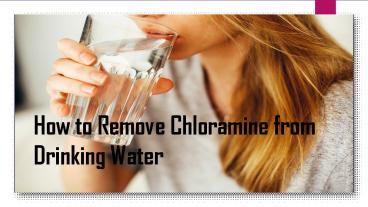How to remove chloramine from drinking water PowerPoint PPT Presentation
Title: How to remove chloramine from drinking water
1
How to Remove Chloramine from Drinking Water
2
Contaminate Drinking Water
- The water you drink, the water you use to clean
your body and the water you use to wash your
dishes all are contaminated with pollutants. - According to UNICEF, more than 3000 children die
every day globally due to consumption of
contaminated drinking water. Furthermore, as per
the stats, on an average 250 million people
worldwide succumb to ailments caused by water
pollution. - Keeping statistics and the ongoing situation in
mind, public water supply companies understand
how toxic and harmful the raw and untreated water
can be. And that is why these companies use two
agents to disinfect the water, namely chlorine
and chloramine.
3
Lets take a detailed look at it and understand
what chloramine is?
- Chloramines are commonly form when ammonia is
added to chlorine to treat drinking water and
provide long-lasting disinfection. - Municipalities add a mixture of chlorine and
ammonia to the water supply to form chloramine
which quickly dissolves in water and kills
bacteria in it.
4
Why is there a necessity to remove chloramine if
it is a disinfecting agent?
- According to experts, chloramine levels of up to
4milligrams per litre in your water are safe for
drinking. However, exceeding the level will pose
a significant risk to your health. - Moreover, water treated with those agents
(Chlorine and Chloramine) have an unpleasant
smell and taste. Apart form this, the taste and
the smell are well-enough to make you feel sick.
5
Carbon filter that is designed for chloramine
removal
- Therefore, to avoid risking your health, it is
recommended to install a quality carbon filter
that is designed for chloramine removal. - The filter uses reverse osmosis or cation
filtration to remove chlorine that is present in
the form of chloramine molecule. Using a carbon
filter can eliminate the chances of having
ammonia particles as well.
6
Health-Related Risks with Chloramine
- Mentioned below are some health-related risks
associated with chloramine that will help you
understand the need to have an appropriate
filtration system better. - Respiratory problems such as sniffling, sinus
blockage, wheezing, shortness of breath and
asthma. - Skin problems include rashing dry skin, itching
flaking, cracking scarring, bleeding
pigmentation, psoriasis to name a few. - Kidney and blood related problems
- Stomach related and gastric problems
7
Filters that Help with Chloramine Related Problems
Reverse Osmosis
Activated and Catalytic Carbon
Ultraviolet Light
8
Get in Touch

